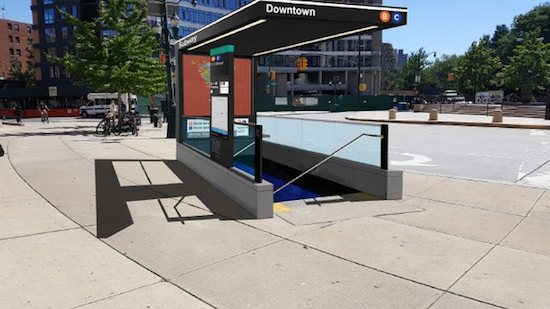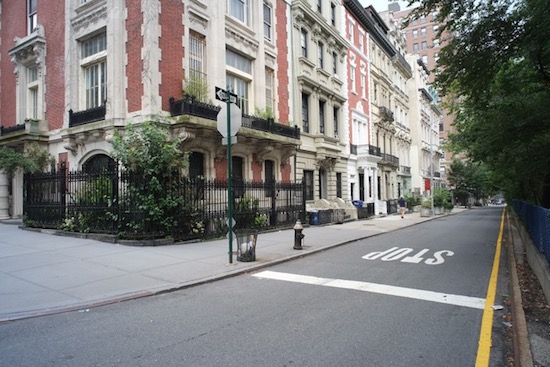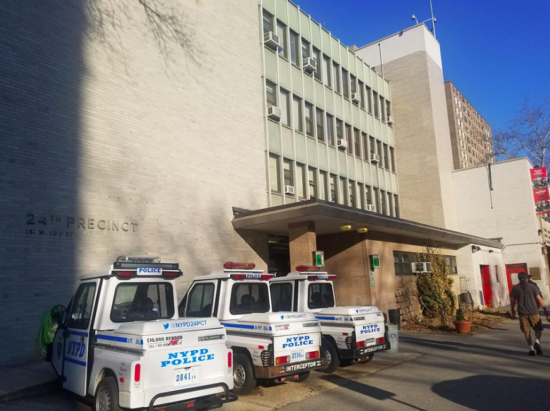
A rendering of the new 110th Street station after planned upgrades.
Assembly Member Linda Rosenthal says the MTA took a “negligent approach” to telling Upper West Siders that three subway stations — the B-C stations at 110th, 86th and 72nd Street — will be closed for up to six months. In a letter sent to MTA Chairman Joe Lhota, she demanded that the agency halt its plans until they present them at a public hearing. We’ve posted the whole letter below.
Rosenthal says the MTA did not tell her in advance about the station closures in her district and she is “dismayed” that there are “no plans to provide extra M10 and other bus service or trains on nearby lines during the closures.” Rosenthal also criticized the agency’s failure to include elevators in the stations upgrades, given the $111 million price tag (which also includes a station on 163rd Street).
“We’re committed to continuing to work with local elected officials and will respond to the Assemblywoman’s letter directly,” wrote an MTA spokesman in response.
While the state — and particularly the governor — controls the MTA, state legislators have often taken a hands-off approach to the agency, holding few if any hearings into the agency’s notoriously high capital costs, for instance. But with these station closures set to impact tens of thousands of commuters, local legislators have criticized the agency’s process. Assembly Member Daniel O’Donnell said the agency’s decision not to include upgrades like elevators for people with disabilities was “shameful.”
New York City Transit Authority president Andy Byford has said that elevators are not feasible at many of the stations receiving upgrades.
West Side Rag broke the story about the planned closures last week after they were detailed at a sparsely attended Community Board 7 Transportation Committee meeting. The first station — 110th Street — is expected to be closed on April 9, just six weeks from now.
2018 MTA Subway Station Closure Letter by westsiderag on Scribd









Ugh. Linda means well, but if she had been at the Community Board meeting, a lot of her questions would have been answered.
doesn’t Rosenthal realize that LED handrail is expensive
And I heard about these closings last year, so rosenthal missed the boat somehow!
I totally agree that it is outrageous that no elevators are being installed as part of the renovation.
Thank You Linda Rosenthal for questioning this series of closures with no contingency plans. Extra buses would be a great help to some degree.
elevators are a good idea….but I would assume it would require major, major construction adjacent to the CPW apartment buildings, adding years to the project and probabaly an extra 500 million.
I watched for much more than a year the slow progress of the 23st lexington ave elevator
The MTA is out of compliance with the Americans with Disabilities Act. Installing elevators are laborious and time consuming but will benefit a large number of people with disabilities and reduce the need for access-a-ride. https://www.nytimes.com/2017/03/29/opinion/new-york-has-a-great-subway-if-youre-not-in-a-wheelchair.html
Can anyone tell me why elevators at ANY of these stations is not possible? I’m looking for real facts here not heresay. Thanks!
Here is an article from DNA.info from 2015 about the issue. The cost is $15 million per elevator (not taking into account cost overruns)
https://www.dnainfo.com/new-york/20150922/park-slope/mta-park-slope-if-you-want-subway-elevators-find-15-million
Check out previous thread(s) in this blog on same topic. One commenter explained extensively and repeatedly.
There is a third type of station, where the turnstiles are at street level and the stairs go straight to the platform. The 72nd St. station for the 1,2,3 is an example of that type of layout. However, these type of stations are obviously not that common, that’s why we’re having this conversation.
The reasons vary based on stations and surrounding locations. I’ll touch on a few.
There are basically two types of stations. Those with a mezzanine level just one flight of stairs below grade where the turnstiles are located as well as a ticket agent and then another set of stairs to go down to platform level. These stations normally have a larger mezzanine level that services both uptown and downtown trains. With out considering existing structures above the mezzanine, these stations are the most adept to having an elevator retrofitted. However there may still be limitations to install another elevator from the mezzanine level to the platform based on existing conditions. For example platform widths, space available, structural column placement, etc.
The other type of station (most of them) is the one where there is no mezzanine and only one level change between street and platform. These types of stations tend to have much smaller areas (vestibules) before the turnstiles and as a whole will be more challenging to install an elevator due to the lack of real estate.
Consider that elevators cannot go to the middle of a platform without having people go through a pay point first. In other words, the elevator must always be located before the turnstiles or gates. Assuming there is enough space above street level to install an elevator it would require complete demolition of the station entrance in order to make space for the elevator well. If the station only has one entrance this would mean complete closure for a long period of time, likely more than a year.
In addition to the space constraints there are also other challenges related to private property, building foundations, relocation of utilities, and maintaining subway service. More on the latter, stations with island platforms and single point of entries are particularly difficult if not impossible. It would likely require the tunnels to be widened in order to spread the tracks and make room for the elevator. This would require service interruption in both directions for more than a year which is of course unacceptable.
Trying to fit elevators to stations that were built 100 years ago and never meant to have one is unfortunately impractical and many times technically unfeasible.
Further, these stations have such narrow footprints since they are stacked with the uptown above the downtown. 81st could probably do it, but I don’t think they can add it to the others. But the express stops on the 1-2-3 in the neighborhood do have elevators.
But I have never understood why the he’ll the MTA always puts in double door elevators. It makes no sense, especially when they aren’t needed. Double the mechanical parts doubles the chance of a breakdown.
It’s for the sake of space or rather, the lack of it. A single door elevator needs a large offset pocket to house the door as it slides open. Double doors are half the width and are easier to tuck in as they open.
Not what I meant by double doors. I meant the doors that open on one side on the platform and then open on the other side for the street, or the like.
I agree that elevators would be optimal – I will be realistic and say there should at least be one every few stations, as there are on Broadway.
That being said, the current entrances to most of these stations are directly adjacent to large buildings, with relatively narrow sidewalks. There is nowhere to put a elevator and its relatively large footprint directly above the stations, and creating a space to do so would likely involve damaging the structural integrity of the buildings. Plus the platforms are generally not very wide so even if you can get one from the street into the station, getting one down to the lower downtown track would be very difficult.
The best bet for installing an elevator in the area is likely at 81st Street.
Every time there is a station upgrade it should include elevators or not be upgraded at all; whats the point??
I pretty much agree with everyone here that if you are going to close a station for that long for renovations, you must include an elevator in that renovation. This is standard around the world in modern subway systems. Every time I see an elderly person or a parent with a stroller attempting to traverse the steps, it gives me anxiety.
When elevators aren’t added, escalators and ramps can be investigated. This would not address all needs but still ease transportation for those with mobility difficulties, bad backs, knees, seniors, baby carriages, luggage. At the Feb 22 MTA hearing with public testimony, I raised the point . The new president Andy Byson reiterated this in his subsequent comments.Please voice your support.
Miriam,
Unfortunately, escalators and ramps take up more space than an elevator. It’s actually more difficult to install these than an elevator at times.
Escalators cannot go in place of existing stairs as they are not considered acceptable paths of egress. They do provide relief to some people with mobility challenges but do nothing for wheelchair and mobility scooter users. Escalators are also notorious for being maintenance intensive, particularly units installed underground where water leaks can cause damage, so every subway station.
As for ADA ramps, they cannot have a pitch of more than 5% (for every 1″ vertical rise 12″ ramp length). In other words these ramps would take a lot switch backs and hence a lot of space, assuming there is any.
The focus should really be to pressure the MTA and Albany to improved Access-a-Ride. If you watch the MTA Board meetings every month you see a large contingent of folks with horror stories of the dismal, subhuman service Access-a-Ride provides. This service needs to improve to a level where people are not left stranded for hours at a time with no options.
It would also help to have more ADA taxi cabs in the fleet. I agree NYC is one of the least friendly ADA cities in the US but it can change and it really should. But screaming at the MTA to add elevators, escalators and ramps when it simply is not possible is not going to get us anywhere. Let Albany know how you feel and what is happening on a daily basis. They control the MTA budget, they have the power to make these changes.
Re escalators: Many stations have more than one set of stairs for entry and exit. Escalators can replace one of these sets. This is an avenue to explore when an elevator isn’t being installed, which will reach many people with mobility difficulties, baby carriages, luggage.Because it doesn’t aid the needs people in wheelchairs doesn’t mean it shouldn’t be available to larger numbers of strugglers and their needs.
There is a ramp at Union Square station. Is that the only ramp in place at over 400 stations? Surely other stations in the system would also have the space needed.
Re Access A Ride:I have been attending the MTA meetings and testifying and also have worked with people who use Access-A-Ride and am very familiar with hearing their problems, stranded, disregarded. This has been going on for decades
Many stations do have more than one set of stairs but that doesn’t mean you can replace them with escalators. A number of stations are in fact out of compliance with modern building codes but because the subway system predates these newer codes they are grandfathered in. Same reason why older high rise building don’t have fire sprinklers but the new buildings do.
Installing escalators in the place of existing stairs further aggravates the issue of emergency egress. It’s also not approved by the NFPA, which is the fire and life safety code public transportation agencies follow. Notice how most of the new stations that have been built in the past 10 years have both a large set of stairs next to escalators. That’s because you can’t have escalators without stairs but you can have stairs w/o escalators.
Yes, Union Square has a ramp from the mezzanine to the platform. Next time you’re there, notice the size of its footprint and project that footprint up to the next connecting level. You can pace it as to get a rough size. Remember how many steps for the width and depth, then when you go to another station w/o elevators or escalators try to pace out the same footprint.
People with mobility can and do climb escalators when the escalators aren’t working, Their entrance and exit isn’t blocked . If there are multiple sets of stairs, there are alternstives if the escalator isn’t working..Many subways don’t have multiple sets of stairs.
Of more than 400 subways, surely some can accommodate ramps.
Zulu, my impression is that back in 1994, the MTA responded to a lawsuit by preparing a list of 100 stations they would add ADA access to before 2020 – so, a 26-year plan – and since 24 years later they are still working through that 26-year plan, they have not updated the list or considered adding additional stations as ADA-compliant since then.
I notice here that the MTA just NOW agreed to hire a consultant to pencil the feasibility and cost of including ADA access. https://mobile.nytimes.com/2018/02/22/nyregion/subway-cosmetic-upgrades.html
My impression is they’ve been dismissing calls for accessibility for decades based on the “moving utilities, it’s hard” line.
I also can think of ways to have fare gates before the elevator, so to me that’s definitely not a gating issue, but maybe I need to hang my shingle out for a million dollar contract with the MTA.
Hi Margaret,
I’m almost sure that out of those 100 stations only a small fraction received the promised improvements. I understand the frustration.
The moving-utilities-is-hard excuse is not just an excuse and it’s not just the only reason for not having done some of these improvements but it is definitely real. Dealing with Con-Ed is an exasperating endeavor. It can take years before they acknowledge work requests and even longer before they are ready to do the work. They don’t care if it’s the MTA calling or a private home owner, their response to these type of work requests are just as bad. If it’s not a gas leak or a blown transformer it’s going on the back burner (no pun intended).
Utility relocations will also require NYC DOT approvals for road closures which is another black hole of despair. It can also impact surrounding customers with potential service interruptions and depending who those customers are, well it may or may not happen.
If you have a solution to the gating issue, I’m sure the MTA would like to hear it. In fact, so would I, genuinely.
The MTA does have a Small Business Mentoring Program if you’re interested. Women owned businesses in this industry is rare but yet Albany requires just as high a participation than for minority owned businesses. There are also categories for veteran and disadvantaged owned businesses. If you’re interested in learning more, start here: https://web.mta.info/sbdp/tier1.htm
MTA and Lhota are looking for a lawsuit.
These closures will coincide with another MTA plan starting this fall which will skip 1 trains from stopping at the very busy 168th St. station. So any of us in the west 60s to 80s who need to go to Columbia Medical Center are out of luck. No 1 trains stopping at the destination and no C trains at an appropriate starting point. Great timing, MTA. Thanks for nothing.
The more practical solution would be to install an easy climber at the station. It enables a disabled person to ascend stairs in the comfort of a chair. My uncle got one put in at his home and it only cost $1,000.
For the price of one elevator ($15mm) we could get 15,000 easy climbers. But I guess if the installation is done under union rules, it may only get us 3,000 easy climbers (unions are 5x as expensive as private sector, according to research studies).
Still 3,000 easy climbers would help out a lot of disabled people and we should do it starting now.
The easy climber might be a solution for stations with wide stairs. But it’s not likely for the ADA to approve a device that would effectively reduce the width of already narrow stairs. It also does not help wheelchair users traveling on their own. Once they get on the easy climber their wheelchair would stay behind unless somebody carries it up or down for them.
The better solution is to improve Access-a-Ride.
The 110th Street Subway is not an uptown -upstairs and downtown -downstairs subway. Everyday I see people who need assistance because they may be elderly, have disabilities or they may have a baby stroller. An elevator isn’t a wish but a necessity.